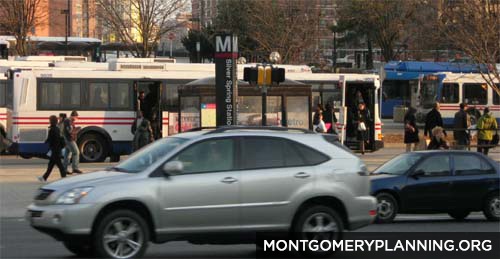In response to concerns from the development community about the high and disproportionate cost of frontage and off-site mitigation improvements, the Montgomery County Planning Board adopted policies to enable waivers and fee-in-lieu payments under certain circumstances for frontage improvements, and updated the 2022 Local Area Transportation Review (LATR) Guidelines to impose an “LATR Proportionality Guide” (i.e., a cap) on the total amount of off-site improvements that can be required for any given project.
Many development projects in Montgomery County are required to make on- and off-site frontage improvements in connection with development approvals. Frontage improvements can include, for example, sidewalks and bike paths along the property’s frontage. Off-site requirements can include similar types of improvements as well as other roadway and transit improvements. The cost of these improvements are sometimes out of proportion to the size of the project, or the project’s impact on public transportation infrastructure.
To provide applicants with greater certainty and to help ensure that the costs of off-site improvements are proportional to a project’s impacts on public infrastructure, the Planning Board added an LATR Proportionality Guide to the LATR Guidelines, which functions similar to a cap. The LATR Proportionality Guide is calculated as follows: (Extent of Development) x (LATR Proportionality Guide Rate) x (LATR Proportionality Guide Adjustment Factor).
The Extent of Development is the number of residential units or square footage of non-residential development. The LATR Proportionality Guide Rate is the same rate as the current County transportation impact tax rate for that type of development in the County’s Orange Policy Area. These rates can be adjusted biennially. And the LATR Proportionality Guide Adjustment Factor is the Non-Auto-Driver Mode Share (NADMS) goal established in the 2020-2024 Growth and Infrastructure Policy. These goals generally range between 22-55%, depending on the particular area within the County.
The County’s current Growth and Infrastructure Policy and LATR Guidelines provide the framework for assessing the adequacy of public infrastructure surrounding a project. As part of a LATR transportation study, applicants will assess the public infrastructure surrounding the project, identify any deficiencies, and calculate the LATR Proportionality Guide. If the cost of addressing any deficiencies through off-site mitigation improvements exceeds the LATR Proportionality Guide, then improvements will be prioritized so as not to exceed the LATR Proportionality Guide amount.
Additionally, under the revised LATR Guidelines, while the County generally prefers construction of off-site improvements, mitigation payments in lieu of construction may be acceptable when mitigation projects may not be practicable due to:
- Unattainable right-of-way;
- An existing CIP project;
- Other operational conditions outside of the applicant’s control; or
- When not considered practicable by the Planning Board and the Montgomery County Department of Transportation.
For frontage improvements, the Planning Board adopted policies for de minimis criteria for very small development projects and payment or partial payment in lieu of constructing frontage improvements. These policies are designed to prevent disproportional frontage improvements on very small projects, or under particular circumstances. Under these guidelines, certain types of small development projects may make a de minimis payment instead of constructing bike paths and sidewalks.
For projects that do not meet the de minimis criteria, payment in lieu of constructing frontage improvements may apply when there are:
- Severe environmental impacts in areas with wetlands, floodplains, significant grades, or forest conservation easements; or
- Changes to the roadway section that would be unsafe.
Applicants may request a partial payment and construct a partial frontage improvement if:
- The frontage improvements involve bikeways without connectivity;
- There are timing problems with a public project; or
- The Maryland State Highway Administration is unwilling to issue an access permit.
For projects where partial payments and partial improvements are recommended, applicants are required to prepare the site for the future frontage improvement and pay the difference between the full cost of the project and the cost of the partial frontage improvement.
For questions about any of these new policies, please feel free to contact me or any of our Land Use attorneys.
For questions about any of these new policies, please contact any of our Land Use attorneys.


